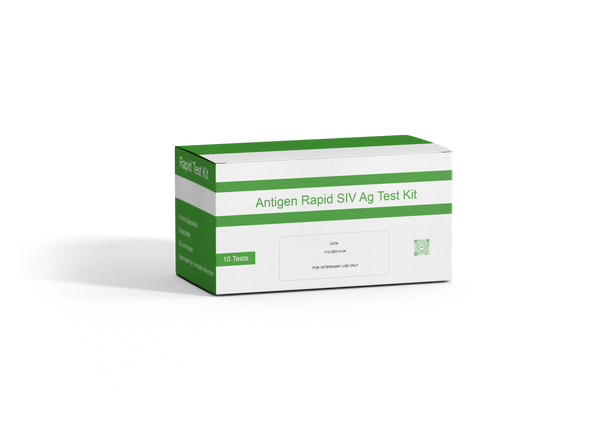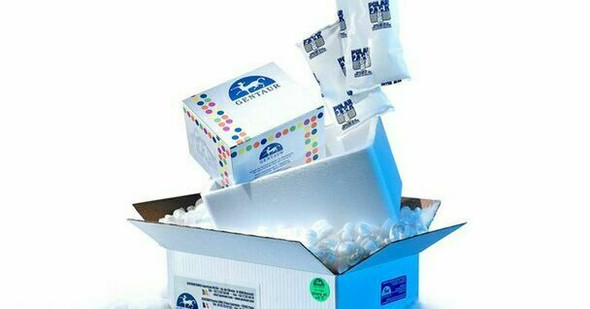Description
Simian Immunodeficiency Virus (SIV) is the most closely related lentivirus to Human Immunodeficiency Virus (HIV), therefore, SIV infection in monkeys has become the best animal model for studying the pathogenesis of and efficacy of vaccines against HIV infection in humans. (1-7,10-12)
The ZeptoMetrix Western Blot Assay is a qualitative enzyme immunoassay for the in vitro detection of antibodies to SIV in serum or plasma. It is supplied for research purposes only. It is not intended for use in the diagnosis or prognosis of disease, or for screening and may not be used as a confirmatory test in diagnostic situations.
Zeptometrix | 0801500 | SIV Strip Kit - 10 Strips Datasheet
Zeptometrix | 0801501 | SIV Strip Kit - 30 Strips Datasheet
PRINCIPLE OF THE TEST
Nitrocellulose strips contain SIVMAC viral proteins resulting from electrophoresis and electroblotting of detergent disrupted virus particles. (8,9) A serum control band is included on each strip to minimize the risk of false negative results due to operational error.
Individual strips are reacted with diluted serum or plasma specimens. If specific SIV antibodies are present, they will bind to the SIV proteins on the nitrocellulose. The strips are washed to remove unbound material. The bound antibodies are visualized by subsequent reaction with goat anti-human IgG conjugated with alkaline phosphatase, followed by BCIP/NBT substrate.
REAGENTS
Materials Supplied:
• SIV Nitrocellulose Strips (10 or 30 strips): Contains electrophoretically separated SIV proteins. Also contains bovine proteins as a blocking agent.
• Non-Reactive Control (1 vial, 100 l): Serum or plasma non-reactive for HTLV, HCV, HIV, SIV and Hepatitis B surface antigen. Contains 0.1% sodium azide as a preservative.
• Reactive Control (1 vial, 100 l): Heat inactivated serum or plasma containing a high titer of antibodies to SIV. Contains 0.1% sodium azide.
• Blotting Buffer (1 bottle, 125 ml): Contains Tris, NaCl, non-immune goat serum and Tween-20®. Contains 0.1% sodium azide as a preservative.
• 20X Wash Buffer (1 bottle, 100 ml): Contains Tween-20®, Tris, and NaCl. Contains 0.1% sodium azide when diluted as a preservative.
• Conjugate (1 vial, 100 l): Goat anti-human IgG (heavy and light chain) antibodies. Contains Tris, NaCl and non-immune goat serum. Contains 0.1% sodium azide as a preservative.
• Substrate (1 bottle, 75 ml): 5-bromo-4-chloro-3-indolyl-phosphate (BCIP) and nitroblue tetrazolium (NBT) in a buffered solution.
• Blotting Powder (1 packet, 10 g): Nonfat dry milk
• Incubation Trays: 1 or 3, 10 well trays.
® Tween- 20 is a registered trademark of Croda International PLC
Materials required but not supplied:
• Rocking platform
• Aspirator with disinfectant trap
• Disposable gloves
• Calibrated adjustable micropipettes
• Graduated cylinders and assorted beakers
• Timer
• 1% sodium hypochlorite as disinfectant. May be prepared from household bleach
• Distilled or deionized water
• Tweezers or forceps
STORAGE
• To avoid microbial contamination store kit reagents tightly capped and at 2-8 C when not in use
• Do not use kit beyond its expiration date
• Use reagent grade water for diluting kit reagents
• Reusing trays is not recommended
• Keep all reagents tightly capped and refrigerated when not in use
• Allow strips to reach room temperature before opening tube. Close tube immediately after removing strips for use.
• Allow reagents to reach room temperature before use
• Do not touch strips with fingers. Use forceps when removing strips from tube.
PRECAUTIONS
• Prior to performing the assay, carefully read all instructions.
• Handle assay specimens, strips, non-reactive and reactive controls as if capable of transmitting infectious agents. Although the virus proteins on the nitrocellulose strips have been inactivated, the reactive control has been heat inactivated and the non-\reactive control has been found negative for HIV, HCV and Hepatitis B surface antigen, no test can offer assurance that products derived from human or non-human primate blood will not transmit infectious agents.
• Use Universal precautions when performing this assay (MMWR, June 24, 1988, Vol. 37, No. 24, pp. 377-382, 387-388).
• Disposal: When testing potentially-infectious specimens, adhere to all applicable local, state and federal regulations regarding the disposal of biohazardous materials.
• Kit components contain sodium azide as a preservative. If disposed of through a sink or other plumbing system, flush with generous amounts of water to prevent accumulation of potentially explosive compounds. See “Safety Management No.CDC- 22, “Decontamination of Laboratory Sink Drains to Remove Azide Salts” (Centers for Disease Control, Atlanta, GA, April 30, 1976).
PREPARATION OF REAGENTS
Assay may be performed as either an overnight or a rapid procedure (3.5 hour total time). The overnight protocol provides additional sensitivity.
1. 1X WASH BUFFER
Dilute 1 volume of 20X WASH BUFFER with 19 volumes of distilled or deionized water. Mix well. Diluted wash buffer may be stored at room temperature for 1 month.
2. 1X WORKING BLOTTING BUFFER
1X WORKING BLOTTING BUFFER should be prepared fresh prior to use.
Dissolve 1.0 g of NONFAT DRY MILK in 20 ml of BLOTTING BUFFER. Mix thoroughly to dissolve the powder. Total volume required listed in table below.
3. 1X WORKING CONJUGATE
1X WORKING CONJUGATE should be prepared fresh prior to use.
Dilute CONJUGATE 1:1000 in 1X WORKING BLOTTING BUFFER. Example; Add 10 ul conjugate to 10 ml of 1X WORKING BLOTTING BUFFER.

TEST PROCEDURE
Allow all reagents to reach room temperature before use. Avoid splashing while handling incubation tray. Do not handle samples or sample loaded pipette tips over uncovered trays. Splashing or aerosols can result in cross contamination of sample wells. Remove lid carefully to avoid condensate from falling into sample wells.
1. Using forceps, remove enough strips from the tube for each sample and for reactive and non-reactive controls. Place numbered side up into each well.
2. Add 2.0 ml 1X WORKING BLOTTING BUFFER to each well, followed by 20 µl of sample or control sera.
3. Cover the tray and incubate 16-20 hrs (overnight method) at room temperature (25±3°C) or two hours at room temperature (rapid method A) or two hours at 37°C (rapid method B) on a rocking platform.
4. Carefully remove cover avoiding splashing or mixing of samples. Aspirate each well into disinfectant trap.
5. Wash each strip 3 times with 2.0 ml 1X WASH BUFFER allowing 5 minutes on the rocking platform between each wash.
6. Add 2.0 ml 1X WORKING CONJUGATE to each well. Cover tray and incubate on a rocking platform at room temperature for 60 minutes (±5 minutes). OR at 37°C for rapid method B, for 60 minutes (±5 minutes).
7. Aspirate each well. Wash strips as described in Step 5.
8. Add 2.0 ml of SUBSTRATE to each well and incubate at room temperature on a rocking platform for up to 15 minutes.
9. Aspirate SUBSTRATE from each well and stop the reaction by rinsing each strip several times with distilled or deionized water.
10. Using forceps, place the strips onto absorbent paper towel, cover with another towel and allow to dry. Score strips as soon as possible after the assay is complete. Strips do not have to be dry prior to scoring. Strips will eventually fade with exposure to light and air. For best results, strips can be mounted and stored between clear plastic sheets. Do not place adhesive tape over bands as this will cause them to fade.
TEST VALIDITY
The REACTIVE and NON-REACTIVE CONTROL must be included in each run.
1. NON-REACTIVE CONTROL: Viral specific bands should not be observed on the nitrocellulose strip used to test the NONREACTIVE CONTROL. The serum control band should be visible as in Figure 1b. The test should be considered invalid and repeated if the serum control band is not visible on the strip.
2. REACTIVE CONTROL: All major molecular weight bands must be visible on the nitrocellulose strip used to test the REACTIVE CONTROL. These bands are p17, p27, p31, gp41, p55, p66 and gp120. Other virus specific bands may also be present such as gp80 and gp160. The serum control band should be visible. Figure 1a provides a guide to the relative positioning of bands observed with the REACTIVE CONTROL.
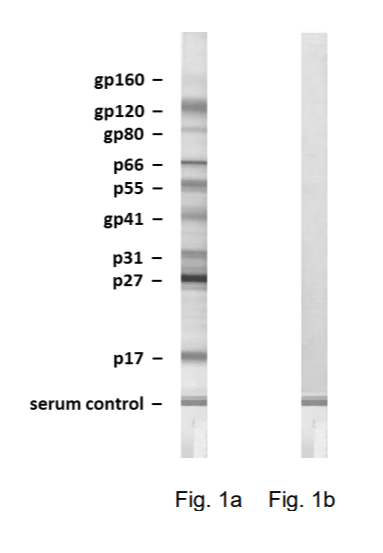
CALCULATION OF RESULTS
To Quantitate Levels of SIV p27:
Using linear graph paper, plot the concentration of SIV p27 Antigen Standard (pg/ml) on the X-axis versus the mean optical densities for each standard on the Y-axis. Then determine the concentration of SIV p27 antigen in specimens by interpolation from the standard curve. Alternatively, the level of SIV p27 may be calculated by computer using a point-to-point algorithm. Be sure to correct for all dilutions, including the 1 to 1.1 dilution made during the addition of Lysing Buffer.
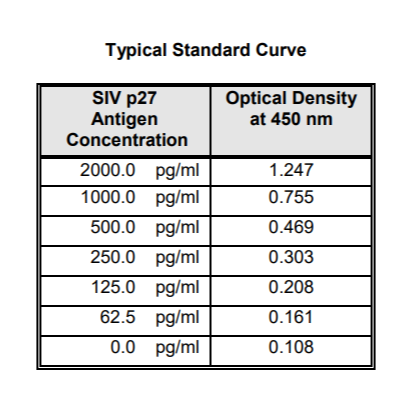
INTERPRETATION OF RESULTS
The presence or absence of antibodies to SIV in a specimen, and the identity of such antibodies is determined by comparison of each nitrocellulose strip to the REACTIVE CONTROL AND NON-REACTIVE CONTROL tested with that run.
The interpretation process is three-step:
1.Establish that the serum control band is present, assuring the sample was added to the well and that the assay was performed properly. The test should be considered invalid and repeated if
the serum control is not visible.
2.Assign each band present a molecular weight based on its position. Use the REACTIVE CONTROL strip in side by side comparison with the sample strip to facilitate this step. Use the illustration
on page 5 to aid in band identification and assignment.
3.Interpretation is based on the combination of bands present. The major SIV gene products used in the interpretation are:
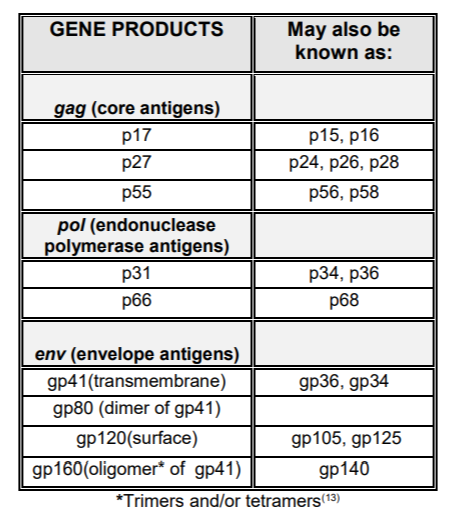
In studies evaluating the ZeptoMetrix Western Blot, a full spectrum of reactivity was observed against gag, pol and env proteins with non-human primate serum or plasma specimens containing antibodies to SIV strains mac, agm, sm, and mne as well as human and non-human primate serum and plasma containing antibodies to HIV-2.
LIMITATIONS OF THE PROCEDURE
• Optimal assay performance requires adherence to the procedures described in this insert. Deviations from the procedure may cause aberrant results.
• Highly reactive specimens may cause overdevelopment of the strip making interpretation of the bands difficult due to strong background staining. Such specimens may be diluted and retested.
• A negative blot result does not exclude infection with SIV.
• Occasionally, reactivity of specimens to bands that do not correspond to SIV antigens may occur. This may be due to antibodies cross-reactive with cellular proteins found in the host cells used to propagate the SIV virus.
4 Reviews
-
va bene
Il pacco è stato veloce, nei tempi previsti ed era ben coperto, quindi è stato un incontro decente.
-
perfecta
Los servicios que prestan y el trato con sus clientes es totalmente perfecto.
-
Excellent
The products are very effective as well as the other services of the company too. Excellent work and progress Gentaur. Keep it up.
-
perfect
I just received this product today. It is easy to use.



